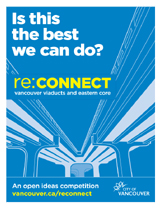As my last post profiled, Vancouver is creatively working to define the future of our Georgia and Dunsmuir Viaducts - infrastructure that I've referred to as "the asterix" beside the statement that Vancouver has no freeways within our city. One of several inputs into that process is an open ideas competition called re:CONNECT.
As my last post profiled, Vancouver is creatively working to define the future of our Georgia and Dunsmuir Viaducts - infrastructure that I've referred to as "the asterix" beside the statement that Vancouver has no freeways within our city. One of several inputs into that process is an open ideas competition called re:CONNECT.

The deadline for submissions has come and gone, and we've been thrilled with the response, with 104 unique submissions from 13 countries (US, Mexico, UK, Ireland, France, Germany, Poland, Turkey, Slovenia, South Korea, Hong Kong, Australia and Canada). The international response is wonderful, but I'm particularly pleased with the number of local entries, showing the great energy and creativity around this key city-building question - 60% of the submissions were from Vancouver, and 75% from Metro Vancouver.
Our exceptional jury of urban experts (led by Great Streets author and urbanist Allan Jacobs), has done their hard work and selected winners and honourable mentions in the 3 categories (Connecting the Core, Visualizing the Viaducts, and Wildcard), in both the fee and free streams. Their picks will be revealed at a public forum on December 1.
On top of the jury's picks though, on-line voting will determine "peoples choice" winners in each category, which will be announced at the same December 1 forum.
And thus the reason for this post ... If you have an interest in the future of the Viaducts and our Eastern Core, I hope you'll study the entries on-line, and help us select our peoples choice winners! You can pick one favourite, or rank and comment on any/all of the submissions. The deadline for voting is midnight, Sunday November 27th.
Although we're excited to see the winners revealed, the real value of the competition is in the totality and diversity of the ideas. Submissions range from the beautification of the viaducts, to their re-use as open space or other uses, or their partial or complete removal and replacement. The visions range from the practical and pragmatic, to the futuristic and whimsical. Submitters appeared to be inspired by everything from water and nature, to our urban past and current housing challenges, to volcanoes, horses, corn-dogs, and knitting yarn!
For readers interested in idea competitions of this type, re:CONNECT is re-confirming my long-held belief that they can be an exceptional way of stimulating creativity and dialogue, and generating out-of-the-box ideas, that no other form of engagement can replicate. Stay tuned - a future post will profile the winners, and my own thoughts on some of the most intriguing ideas.

Manufactured Crisis: Losing the Nation’s Largest Source of Unsubsidized Affordable Housing
Manufactured housing communities have long been an affordable housing option for millions of people living in the U.S., but that affordability is disappearing rapidly. How did we get here?

Americans May Be Stuck — But Why?
Americans are moving a lot less than they once did, and that is a problem. While Yoni Applebaum, in his highly-publicized article Stuck, gets the reasons badly wrong, it's still important to ask: why are we moving so much less than before?

Using Old Oil and Gas Wells for Green Energy Storage
Penn State researchers have found that repurposing abandoned oil and gas wells for geothermal-assisted compressed-air energy storage can boost efficiency, reduce environmental risks, and support clean energy and job transitions.

San Antonio Remains Affordable as City Grows
The city’s active efforts to keep housing costs down through housing reforms and coordinated efforts among city agencies and developers have kept it one of the most affordable in the nation despite its rapid population growth.

What Forest Service Cuts Mean for Cities
U.S. Forest Service employees work on projects that have impacts far beyond remote, rural wilderness areas.

North Texas Transit Leaders Tout Benefits of TOD for Growing Region
At a summit focused on transit-oriented development, policymakers discussed how North Texas’ expanded light rail system can serve as a tool for economic growth.
Urban Design for Planners 1: Software Tools
This six-course series explores essential urban design concepts using open source software and equips planners with the tools they need to participate fully in the urban design process.
Planning for Universal Design
Learn the tools for implementing Universal Design in planning regulations.
Heyer Gruel & Associates PA
City of Moreno Valley
Institute for Housing and Urban Development Studies (IHS)
City of Grandview
Harvard GSD Executive Education
Salt Lake City
NYU Wagner Graduate School of Public Service
City of Cambridge, Maryland



























